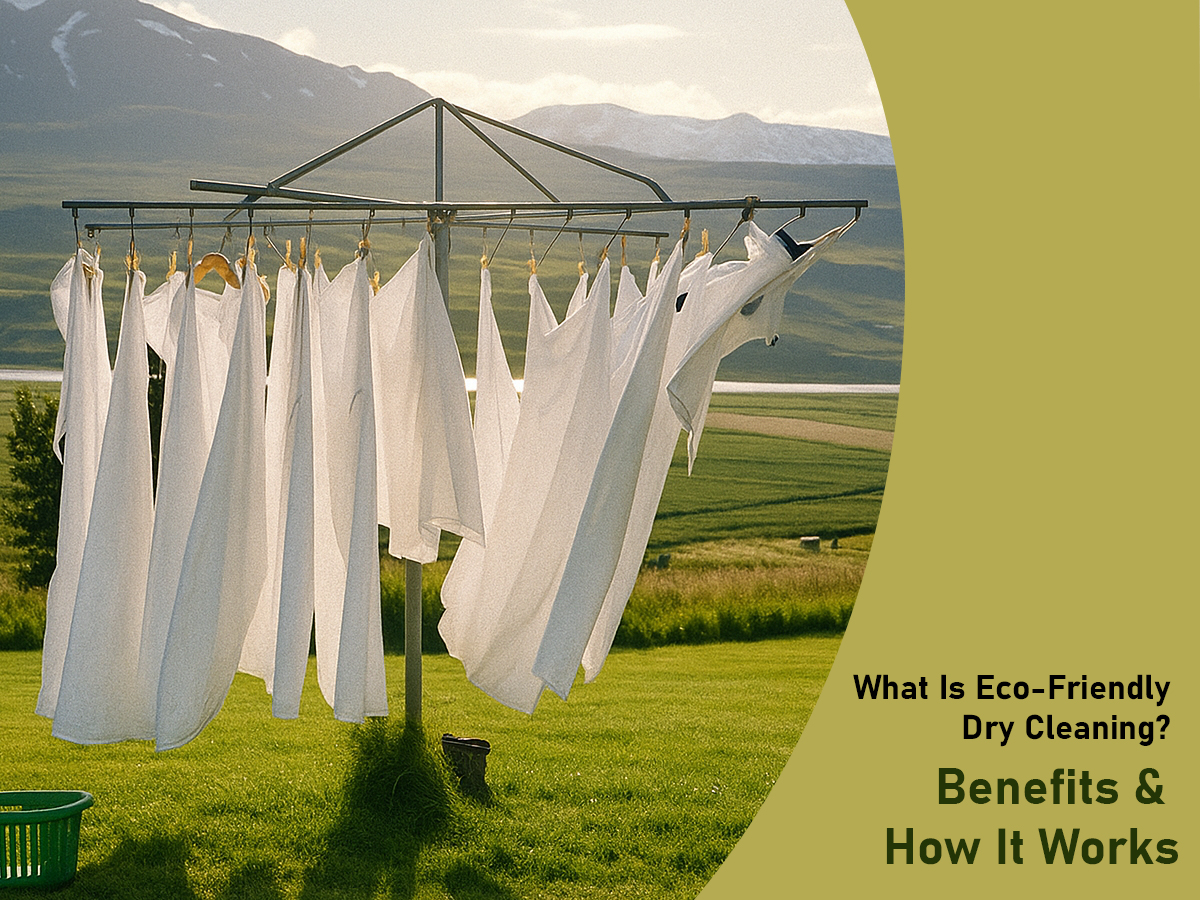
What Is Eco-Friendly Dry Cleaning? Benefits & How It Works
Eco-friendly dry cleaning is changing fabric care by focusing on health, garment longevity, and environmental responsibility. Discover how green dry cleaning works, its benefits, and why switching to environmentally friendly solutions is a good idea for eco-conscious consumers, health-conscious families, professionals, and small businesses.
What Is Eco-Friendly Dry Cleaning?
Eco-friendly dry cleaning, also known as “green dry cleaning,” uses non-toxic, biodegradable cleaning agents and sustainable methods rather than harsh chemicals such as perchloroethylene (PERC). Wet cleaning, CO₂ cleaning, and silicone-based solvents are environmentally friendly alternatives to traditional dry cleaning, decreasing health risks and pollution.
How Eco-Friendly Dry Cleaning Differs
Key Differences
Eco-friendly dry cleaners use safe solvents derived from nature, such as corn-based solvents, liquid CO₂, or sand-based silicone.
Fabric Care: These methods are gentler on garments, preserving their shape, color, and lifespan, and are particularly effective for delicate fabrics and structured pieces.
Environmental Impact: Leading facilities have reduced emissions, use of energy, and hazardous waste by using biodegradable solvents, recycling hangers, and renewable energy sources.
Eco-Friendly Dry Cleaning Methods
Wet Cleaning
Advanced machines use water and special biodegradable detergents to clean things. It’s the best choice for your health and the environment, and it’s great for clothes and skin that are sensitive.
CO₂ Cleaning
This new method uses pressurized liquid CO₂, a non-toxic, recyclable solvent, to clean clothes. It works well to get rid of stains without leaving behind harmful chemicals, and it doesn’t add to greenhouse gas emissions.
Silicone-Based & Hydrocarbon Cleaning
Solvents that are based on silicone, such as GreenEarth, are derived from sand and when broken down, they transform into substances that are not harmful. Although hydrocarbon solvents are less toxic than traditional fluids, the cleaning methods that are preferred by sustainability experts are those that are based on silicone and involve wet cleaning.
Benefits of Eco-Friendly Dry Cleaning
Healthier Living
Environmentally friendly alternatives eliminate exposure to carcinogenic chemicals such as PERC, lowering skin irritations, allergies, and long-term risks. Families, allergy sufferers, and people with sensitive skin benefit the most from chemical-free garment care.
Superior Fabric Care
Gentler methods extend the life of clothing, helping it to retain its shape, color, and softness. Experts recommend green cleaning for silks, wools, and designer garments to avoid chemical damage.
Environmental Protection
Biodegradable solvents, energy-efficient machinery, and recycling practices substantially lower the carbon footprint of professional Dry cleaning services. Some providers use wind and solar energy to power their facilities, and reuse wood for hangers and packaging.
Support for Sustainable Lifestyles
Consumers who choose an eco-friendly dry cleaner are actively contributing to the reduction of chemical pollution and increasing awareness of overall environmental responsibility across businesses. More than 60% of consumers prefer sustainable services, indicating an increasing need for green garment care.
Expert Insights & Trust Factors
Dermatologists advise chemical-free washing for skin safety; fabric specialists support less harmful solvents for garment longevity; and sustainability experts emphasise the need of reducing environmental effect. When choosing a service, check for certifications such as GreenEarth, CED, or Green Business Bureau, which indicate true environmentally friendly activities and commitment to safety regulations.
Case Studies: Businesses like Mulberrys Garment Care (carbon neutral and powered by renewables) and Edoya in Japan (natural soaps and starches) set industry benchmarks, proving eco-friendly dry cleaning is both effective and commercially viable.
How to Choose the Right Eco-Friendly Dry Cleaner
Confirm using wet cleaning, CO₂ cleaning, or silicone-based solvents.
Check for trustworthy certificates, transparent disclosures, and positive feedback.
Evaluate the recycling and energy methods.
Ask about solvent disposal and worker safety.
Conclusion: Make the Greener Choice
Eco-friendly dry cleaning is a safer, more sustainable method to preserve clothing while also protecting one’s health. Choose eco-friendly dry cleaning for a healthier lifestyle, longer-lasting garments, and a conscientious commitment to a greener environment.


